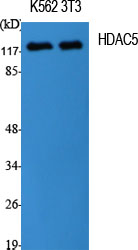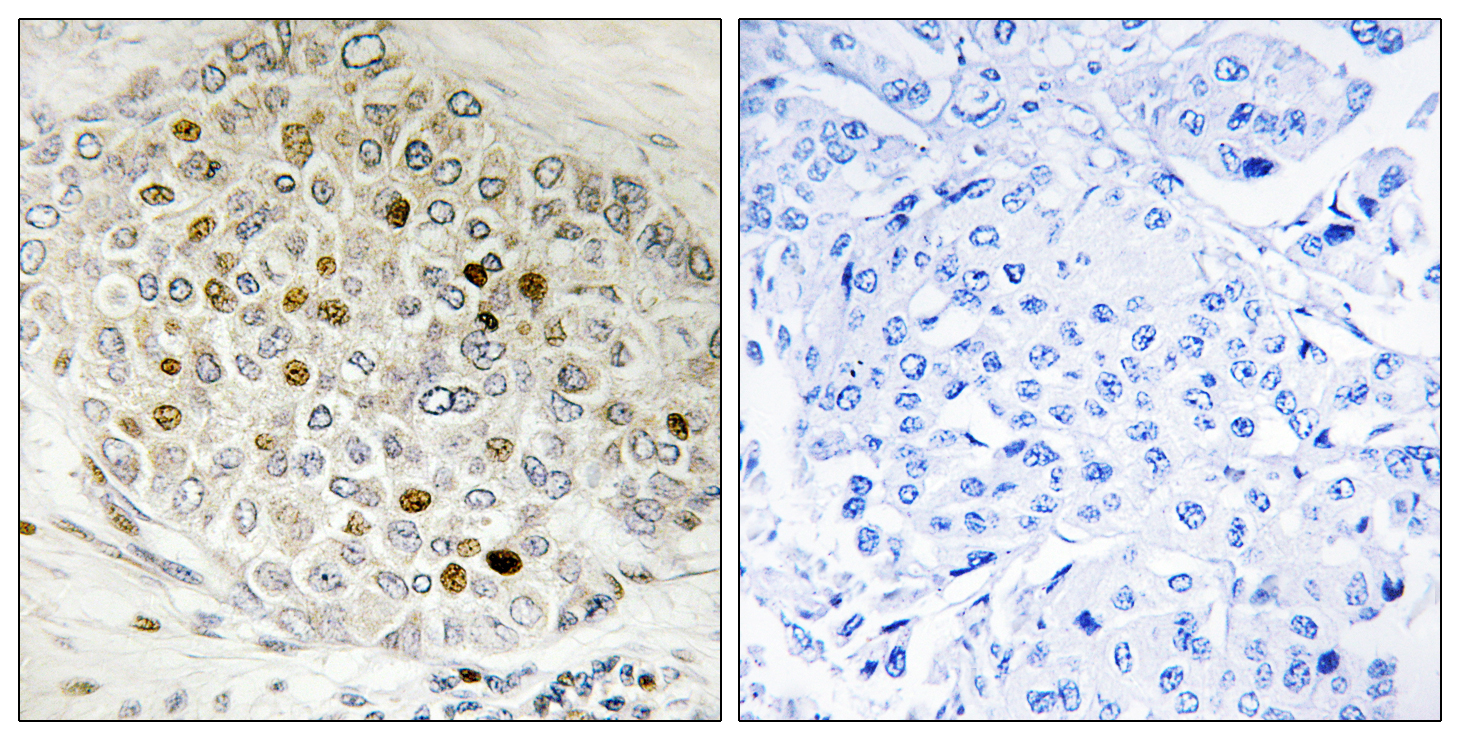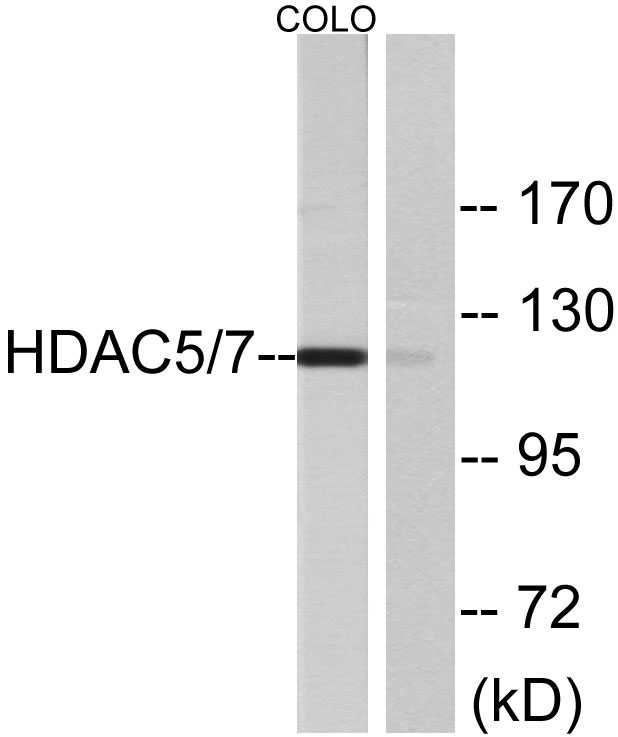HDAC5 Polyclonal Antibody
- Catalog No.:YT2116
- Applications:WB;IHC;IF;ELISA
- Reactivity:Human;Mouse
- Target:
- HDAC5
- Fields:
- >>Apelin signaling pathway;>>Neutrophil extracellular trap formation;>>Alcoholism;>>Viral carcinogenesis;>>MicroRNAs in cancer
- Gene Name:
- HDAC5
- Protein Name:
- Histone deacetylase 5
- Human Gene Id:
- 10014
- Human Swiss Prot No:
- Q9UQL6
- Mouse Swiss Prot No:
- Q9Z2V6
- Immunogen:
- The antiserum was produced against synthesized peptide derived from human HDAC5. AA range:464-513
- Specificity:
- HDAC5 Polyclonal Antibody detects endogenous levels of HDAC5 protein.
- Formulation:
- Liquid in PBS containing 50% glycerol, 0.5% BSA and 0.02% sodium azide.
- Source:
- Polyclonal, Rabbit,IgG
- Dilution:
- WB 1:500 - 1:2000. IHC 1:100 - 1:300. IF 1:200 - 1:1000. ELISA: 1:20000. Not yet tested in other applications.
- Purification:
- The antibody was affinity-purified from rabbit antiserum by affinity-chromatography using epitope-specific immunogen.
- Concentration:
- 1 mg/ml
- Storage Stability:
- -15°C to -25°C/1 year(Do not lower than -25°C)
- Other Name:
- HDAC5;KIAA0600;Histone deacetylase 5;HD5;Antigen NY-CO-9
- Observed Band(KD):
- 122kD
- Background:
- Histones play a critical role in transcriptional regulation, cell cycle progression, and developmental events. Histone acetylation/deacetylation alters chromosome structure and affects transcription factor access to DNA. The protein encoded by this gene belongs to the class II histone deacetylase/acuc/apha family. It possesses histone deacetylase activity and represses transcription when tethered to a promoter. It coimmunoprecipitates only with HDAC3 family member and might form multicomplex proteins. It also interacts with myocyte enhancer factor-2 (MEF2) proteins, resulting in repression of MEF2-dependent genes. This gene is thought to be associated with colon cancer. Two transcript variants encoding different isoforms have been found for this gene. [provided by RefSeq, Jul 2008],
- Function:
- catalytic activity:Hydrolysis of an N(6)-acetyl-lysine residue of a histone to yield a deacetylated histone.,domain:The nuclear export sequence mediates the shuttling between the nucleus and the cytoplasm.,function:Responsible for the deacetylation of lysine residues on the N-terminal part of the core histones (H2A, H2B, H3 and H4). Histone deacetylation gives a tag for epigenetic repression and plays an important role in transcriptional regulation, cell cycle progression and developmental events. Histone deacetylases act via the formation of large multiprotein complexes. Involved in muscle maturation by repressing transcription of myocyte enhancer MEF2C. During muscle differentiation, it shuttles into the cytoplasm, allowing the expression of myocyte enhancer factors.,PTM:Phosphorylated by CaMK at Ser-259 and Ser-498. The phosphorylation is required for the export to the cytoplasm.,PTM:
- Subcellular Location:
- Nucleus. Cytoplasm. Shuttles between the nucleus and the cytoplasm. In muscle cells, it shuttles into the cytoplasm during myocyte differentiation. The export to cytoplasm depends on the interaction with a 14-3-3 chaperone protein and is due to its phosphorylation at Ser-259 and Ser-498 by AMPK, CaMK1 and SIK1.
- Expression:
- Ubiquitous.
A novel selenium analog of HDACi-based twin drug induces apoptosis and cell cycle arrest via CDC25A to improve prostate cancer therapy Theranostics Zhiyong Shi WB Mouse,Human PC3 PCa cell-Xenograft PC3 cell
- June 19-2018
- WESTERN IMMUNOBLOTTING PROTOCOL
- June 19-2018
- IMMUNOHISTOCHEMISTRY-PARAFFIN PROTOCOL
- June 19-2018
- IMMUNOFLUORESCENCE PROTOCOL
- September 08-2020
- FLOW-CYTOMEYRT-PROTOCOL
- May 20-2022
- Cell-Based ELISA│解您多样本WB检测之困扰
- July 13-2018
- CELL-BASED-ELISA-PROTOCOL-FOR-ACETYL-PROTEIN
- July 13-2018
- CELL-BASED-ELISA-PROTOCOL-FOR-PHOSPHO-PROTEIN
- July 13-2018
- Antibody-FAQs
- Products Images

- Western Blot analysis of various cells using HDAC5 Polyclonal Antibody
.jpg)
- Western Blot analysis of K562 cells using HDAC5 Polyclonal Antibody

- Immunohistochemistry analysis of paraffin-embedded human breast carcinoma tissue, using HDAC5 Antibody. The picture on the right is blocked with the synthesized peptide.

- Western blot analysis of lysates from colo cells, using HDAC5 Antibody. The lane on the right is blocked with the synthesized peptide.



